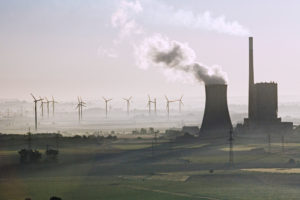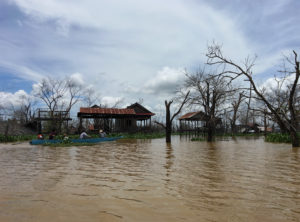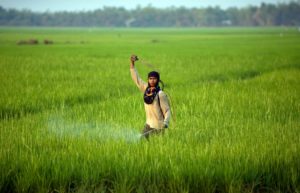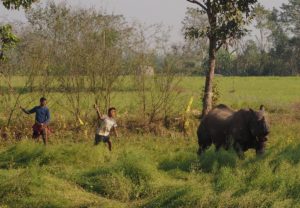In a span of two years, two big generators and a protective fence have been erected in what once used to be a rice field in Cambodia’s Kandal province. These generators are part of a newly built heavy fuel oil plant, which supplies power not to the lightbulbs, phone chargers and fans of the stilted houses in its shadow, but to the power crisis-hit residents of the capital Phnom Penh.
Shortly after her neighbours in Lvea Aem district were ousted from their farmland with USD 20 per square metre in compensation, Sokheng, 43, who only wanted to be identified by her given name, said she watched the fields quickly – and loudly – transform into a power plant in about a year. Much of her community was incensed at the idea of a heavy fuel oil (HFO) plant in their backyard, fearing that power plants bring bad air and poor health.
Many of them [my neighbours] were crying, screaming, because they did not want the power plant facility built here
“Many of them [my neighbours] were crying, screaming, because they did not want the power plant facility built here,” she said. “They want them [the plant constructors] to go somewhere that would not impact the villagers.”
After a year of droughts resulted in an electricity crisis in Cambodia, where the majority of power comes from hydropower dams, authorities sought solutions – largely in the shape of emissions-heavy resources like coal. In 2015-16, successive droughts in Cambodia impacted 2.5 million people, most in rural areas, who depend largely on agriculture as a source of livelihood.
However, the 2019-20 droughts hit urban residents. At the time, hydropower supplied a more significant part of Cambodia’s energy portfolio, accounting for almost half of the 9,000 GWh of generated energy in 2018 and about one-third of the 12,000 GWh generated in 2019, according to the Electricity Authority of Cambodia.
Climate change, severe weather and a spate of hydropower dams on the Mekong have hit river levels in Cambodia and the lower Mekong basin. China has 11 hydropower dams on the mainstream of the Mekong, and 11 more are in various stages of planning through Laos and Cambodia.
A race to meet growing power demand
As Cambodia embraces a boom in commercial construction and light manufacturing, the country’s energy capacity has steadily climbed, increasing about 20.5% annually between 2017 and 2019. Although it is still catching up with neighbours in rural electrification, about 97% of Cambodian villages were connected to the grid as of 2020, a percentage that demonstrates rapid growth compared to the 66.5% electrification rate in 2015.
Coupled with El Niño, the worst drought would come in 2019. Hydropower in the monsoon season in 2019 supplied 1,329 MW, but in the dry weather it could only deliver 399 MW, according to a presentation last year by the state utility Electricite du Cambodge.
After Phnom Penh’s 2019 outages, Prime Minister Hun Sen rushed to find solutions, at one point even requesting an electricity-generating ship from Turkey, though this idea never came to fruition. Businesses large and small which complained about Cambodia’s comparatively high electricity prices now found their profits gouged by frequent power outages.
Through the second half of 2019 and 2020, Cambodia announced a number of new long-term projects aimed at ensuring 2019’s power crisis would not happen again. Chinese companies, particularly state-owned enterprises, have been key to constructing or operating some of Cambodia’s new sources of energy – such as Sinosteel’s involvement in the coal-fired power plant in Cambodia’s Botum Sakor National Park – while national banks including Bank of China and ICBC have financed both Cambodia’s hydropower and coal developments.
Plugging gaps with fossil fuels
Among some of the most controversial plans to substitute insufficient hydropower, Cambodia signed deals with two coal-fired power plants in 2020. This involved the onboarding of a 700 MW coal-fired plant backed by China-backed Sinosteel in Koh Kong province’s concession-covered Botum Sakor National Park, and another 265 MW coal-fired plant in Oddar Meanchey province developed by a Cambodian company.
HFO plant, Kandal province
This was one of the first energy projects to come online after the droughts, in Lvea Aem district, about 20 km outside Phnom Penh
Cambodia also agreed to purchase 2,400 MW of coal-generated power from Laos in late 2019, buying from two plants in its northern neighbour’s Xekong province. As a result of that agreement, Cambodia is pushing to construct a transmission line through Prey Lang Wildlife Sanctuary, a 430,000-hectare mixed evergreen and deciduous dipterocarp forest that has already plundered by logging.
One of the first energy projects to come online after the droughts was the heavy fuel oil plant in Kandal province’s Lvea Aem district, about 20 km outside Phnom Penh. Wärtsilä, the Finnish engineering company, was chosen to build one of the 200 MW generators with Chinese state-owned contractor CGGC-UN Power, while Germany’s MAN Energy and another state-owned company China National Heavy Machinery Corporation developed the second generator.
The country simultaneously started onboarding solar power, signing an additional 140 MW at the end of 2019. However, by the end of the year, solar had made little impact at about 12% of Cambodia’s 3,056 MW of installed capacity, according to projections from the Electricity Authority of Cambodia.
Victor Jona, spokesperson for Cambodia’s Ministry of Mines and Energy, did not respond to requests for comment about the heavy fuel oil plant. But Jan Hoppe, head of communications for MAN Energy Solutions, said the company was contracted to work quickly as part of the Cambodian government’s emergency effort to stabilise electricity supply.
“The new power plant will make a significant contribution to securing the power supply in Cambodia − regardless of weather or climatic conditions. The power plant is connected to the grid and generates electricity when demand is high so that Cambodia won’t face electricity shortages during the upcoming dry season,” he wrote in an email.
Both European companies noted that the HFO-burning generators could be used for lower-emitting LNG. Cambodia received its first shipment of LNG from China in January 2020. And while Cambodia announced a 15-year plan to build an LNG port and pipelines to carry it, analysts from international law firm White & Case suggested the country faces a number of financial and infrastructure barriers before burning LNG at the Lvea Aem plant is realistic.
Despite the government’s expansion of energy sources, Cambodia is likely to experience drought-related energy problems in the future, especially as droughts become more frequent and brutal due to climate change, said Courtney Weatherby, deputy director of the Southeast Asia programme at US-based think tank the Stimson Center.
Cambodia’s recent diversification away from dependency on hydropower will likely mean that the problem is more manageable in the future because Cambodia will have other energy sources available, but droughts are a recurring issue and they are only getting more severe with climate changeCourtney Weatherby, Stimson Center
“Cambodia’s recent diversification away from dependency on hydropower will likely mean that the problem is more manageable in the future because Cambodia will have other energy sources available, but droughts are a recurring issue and they are only getting more severe with climate change,” she said in an email to The Third Pole.
Weatherby noted that the country could instead predict and more proactively respond to droughts, as Vietnam did after the Mekong delta suffered water shortages and salinisation during droughts in 2015 and 2016. Cambodia’s neighbour set up policies including forecasting and alert systems, which reduced the damage, she said.
“One challenge is that a lot of Cambodia’s diversification has been towards coal, which not only has local air pollution impacts but obviously exacerbates climate change.”
A community left in the lurch
Sokheng said villagers only heard about the compensation plan from local authorities, without revealing the plant’s purpose or potential environmental risks. Cambodia’s environmental code suggests that most projects require an environmental impact assessment with public consultation, but the code maintains an exemption for “special and crucial projects approved by the Royal Government”.
Lvea Aem district residents do not interact with workers on the other side of the plant’s tall and camera-covered fence, so Sokheng said she does not know anything about the heavy fuel oil plant’s operations.
When showing The Third Pole the plant, Sokheng’s young son pointed out an occasional spout of water steadily flowing out of the plant’s high concrete fence and into a small stream that runs behind the factory. Residents stopped using this stream for drinking or bathing water many years before the plant’s construction, but she said they still catch some small fish from it and use the water for their plants.
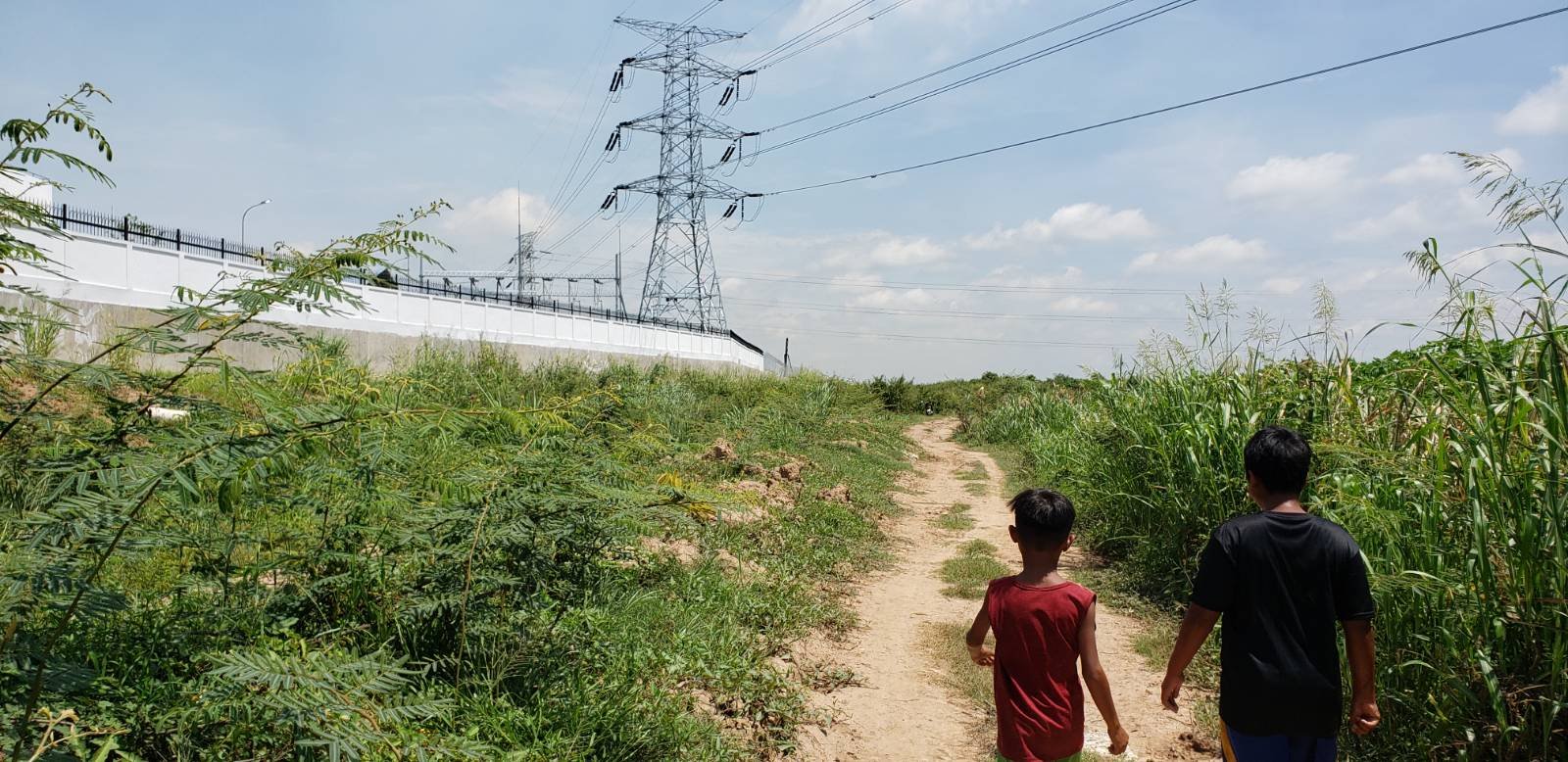
Sokheng said her papayas have not been growing as well as before, with leaves yellowing and stalks seeming to grow shorter. “It looks like it doesn’t want to grow up,” she said of her papaya, adding that she thinks it is because of the water coming from the factory into their stream.
[The power plant] is not helpful, it’s harmful for the community because we use power from elsewhere to supply to the village, we don’t use any power from here, and people around here cannot grow anything
“[The power plant] is not helpful, it’s harmful for the community because we use power from elsewhere to supply to the village, we don’t use any power from here, and people around here cannot grow anything,” she said.
Cambodia’s emissions are expected to skyrocket due to the 2019 energy push. The Economic Research Institute for ASEAN and East Asia projected in a 2020 outlook report that Cambodia’s emissions would rise from just over 3 million tonnes of carbon equivalent in 2020 to 25 million in 2050, if the country continues on its current route.
Some of the multinational brands that carry Cambodia’s export industry, including H&M, Nike and Specialized, have warned Cambodia that the country risks losing their future investments because of its embrace of coal while renewable options are available.
Bridget McIntosh, country director of EnergyLab Cambodia, which promotes clean energy, noted that there are several cheaper, greener and more efficient energy solutions on the horizon, but the country’s rapid adoption of coal and signing of power purchase agreements has locked Cambodia into longer-term commitments.
“Since the 2019 power shortages, Cambodia has signed agreements for so many new power projects, mostly coal, that it is now overcommitted until well after 2030,” she said.
McIntosh said that solar would be more complementary to hydropower, in which Cambodia has already invested heavily. When the monsoons hit, hydropower is highly effective, but solar power can pick up during Cambodia’s languid dry season. “This limited hydro output can be used as the sun goes down to ramp up electricity supply, as coal is not very flexible to ramp up. Solar is very cheap and getting cheaper – but it does need something to balance it so hydro, and in the future batteries or gas-fired electricity will also play a role in this balancing act.”

